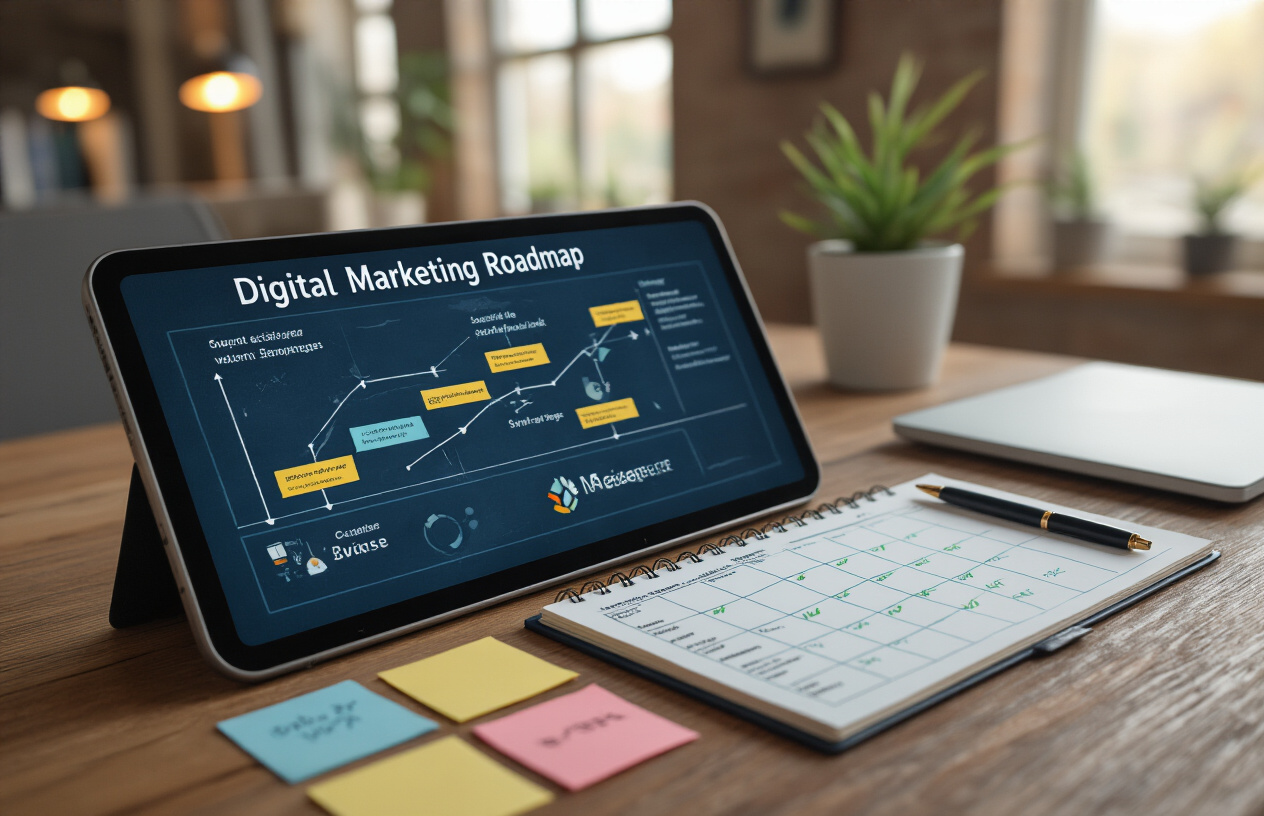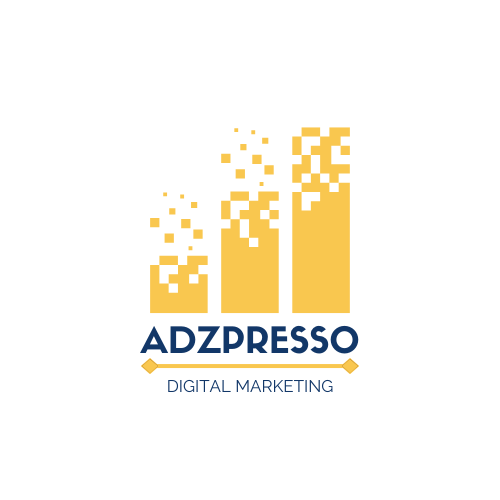Why Every Small Business Needs a Digital Marketing Strategy in 2025
Small business owners can’t afford to ignore digital marketing in 2025. With more customers shopping and researching online than ever before, your business needs a clear digital strategy to stay competitive and grow.
This guide helps small business owners and entrepreneurs develop an effective digital marketing plan without breaking the bank. We’ll cover the changing digital landscape in 2025, essential components of a successful strategy, and budget-friendly approaches that deliver real results.
You’ll learn practical ways to measure your marketing performance and follow a simple implementation roadmap designed specifically for small business resources and challenges.
The Digital Landscape for Small Businesses in 2025

Key Market Trends Reshaping Small Business Competition
Gone are the days when local shops could thrive on word-of-mouth alone. In 2025, the digital marketplace is brutally competitive, and small businesses either adapt or disappear.
The biggest shift? AI-powered personalization has become standard, not premium. Your competitors are using machine learning to predict what customers want before they even search for it. Meanwhile, voice search now accounts for nearly 55% of all searches, completely changing how people find local businesses.
Here’s what’s happening right now:
| Trend | Impact on Small Businesses |
|---|---|
| Micro-moment marketing | Customers expect immediate answers during decision-making moments |
| Shoppable social media | Instagram, TikTok, and Pinterest have become primary sales channels |
| Hyper-local targeting | Geo-fencing technology targets customers within walking distance |
| Sustainability tracking | Consumers demand transparency in business practices |
The scary part? The technology gap between large corporations and small businesses is actually shrinking. The tools that were once only available to enterprises with massive budgets are now accessible to everyone. Your competition isn’t just the shop down the street – it’s every business with a decent online presence.
How Consumer Behavior Has Evolved Since 2020
Remember 2020? That was just the warm-up.
The pandemic-driven digital adoption we saw then has morphed into something far more sophisticated. Today’s consumers don’t just want online options – they demand seamless experiences that blend digital and physical worlds.
Some hard truth: 78% of consumers now research small businesses online before visiting in person, and 67% will immediately dismiss a business with outdated information or poor reviews.
What’s really changed since 2020:
- Attention spans have plummeted to around 4 seconds for deciding whether content is worth consuming
- Trust in traditional advertising has dropped below 15%
- Community validation through reviews and social proof now influences over 80% of purchasing decisions
- Consumers expect 24/7 availability through chatbots or messaging
The biggest shift has been psychological. Convenience isn’t a luxury anymore – it’s the baseline expectation. If your business makes people jump through hoops, they’ll bounce faster than you can say “please fill out this form.”
The Cost of Digital Invisibility in Today’s Market
Digital invisibility in 2025 is basically a death sentence for small businesses.
The numbers are brutal. Small businesses without strong digital presence experience:
- 76% lower customer acquisition rates
- 43% higher customer churn
- 38% lower average transaction values
- 91% less word-of-mouth referrals
Think about it. When was the last time you tried a new restaurant without checking online reviews? Or bought something without comparing prices? Exactly.
Digital invisibility doesn’t just cost you new customers – it erodes your existing customer base. In a recent study, 64% of loyal customers said they would switch to a competitor if they provided a better digital experience.
And the psychological impact can’t be ignored. Many small business owners feel perpetually behind, always playing catch-up while watching digitally-savvy competitors take bigger slices of the market.
The most painful part? The resources needed to establish digital presence have never been more accessible. It’s not about budget anymore – it’s about strategy and execution. Small businesses without digital presence in 2025 aren’t facing a technology problem – they’re facing a mindset problem.
Core Components of an Effective Digital Strategy

Building a Conversion-Focused Website
Your website isn’t just a digital brochure—it’s your 24/7 salesperson. In 2025, small businesses need websites that actually convert visitors into customers.
The math is simple: A pretty website that doesn’t generate leads is just an expensive online billboard. Focus on these elements:
- Clear call-to-action buttons that practically scream “CLICK ME!”
- Mobile-first design (because 72% of small business website visits now happen on phones)
- Page load speeds under 2 seconds (each additional second drops conversions by 7%)
- Customer testimonials positioned strategically near decision points
A good small business website answers these questions immediately: What do you offer? How does it help me? Why should I trust you? What should I do next?
Search Engine Optimization for Local Dominance
The Google game has changed for small businesses. National rankings? Forget about it. Local SEO domination? Now we’re talking.
Your neighborhood customers are searching right now with phrases like “near me” or “in [city name].” If you’re not showing up, your competitors are taking your lunch money.
Start with these local SEO power moves:
- Claim and optimize your Google Business Profile (add photos weekly!)
- Build location-specific landing pages if you serve multiple areas
- Get legitimate reviews from actual customers (aim for 2-3 new ones monthly)
- Make sure your NAP (Name, Address, Phone) is consistent everywhere online
Content Marketing that Drives Customer Action
Content marketing isn’t about blogging for the sake of blogging. It’s about creating stuff your customers actually want to consume.
The small businesses crushing it with content in 2025 aren’t creating generic “5 tips” articles. They’re building decision-enabling content that makes customers think, “These folks get me.”
Focus on:
- Customer pain point content (address specific problems your target audience struggles with)
- Comparison content (your solution vs. alternatives)
- Case studies that show actual results (with real numbers!)
- Educational videos under 2 minutes (attention spans are shrinking)
Remember: One incredible piece that perfectly matches buyer intent beats ten mediocre blogs every time.
Social Media Platforms Worth Your Investment
Stop trying to be everywhere. In 2025, platform-hopping is the fastest way to waste your marketing budget.
Small businesses need to pick their social battles wisely:
| Platform | Best For | Time Investment |
|---|---|---|
| Visual products, local services | 3-4 hours/week | |
| B2B services, professional networking | 2-3 hours/week | |
| TikTok | Youth-oriented brands, personality-driven businesses | 4-5 hours/week |
| Community building, local customer base | 2-3 hours/week |
Choose 1-2 platforms where your customers actually hang out, then show up consistently. Better to own one channel than be mediocre on five.
Email Marketing Automation for Customer Retention
Email marketing delivers $36 for every $1 spent. That’s not a typo—it’s why smart small businesses are doubling down on their email game in 2025.
The secret? Automation that delivers the right message at the right time:
- Welcome sequences that turn new subscribers into first-time buyers
- Abandoned cart recoveries (these can recapture up to 15% of lost sales)
- Post-purchase sequences that turn one-time buyers into repeat customers
- Re-engagement campaigns that wake up dormant customers
Stop manually sending “blast” emails to your entire list. Start segmenting based on customer behavior and watch your retention rates soar.
Budget-Friendly Digital Marketing Approaches

A. Tools That Deliver Maximum ROI for Minimal Investment
You don’t need a Fortune 500 budget to make waves online. Some of the most powerful digital marketing tools cost next to nothing. Google Analytics gives you deep insights into your website traffic for free. Canva lets you create professional-looking graphics without a design degree. And email platforms like MailerLite offer robust features before you ever hit a paid tier.
The secret? Stack these tools strategically. Use Facebook’s targeting capabilities (which are still impressive on a $5/day budget) to drive traffic to a landing page you built with a free WordPress template. Track conversions with Google Analytics, then nurture those leads with automated email sequences.
Small businesses crushing it in 2025 aren’t outspending their competition – they’re outthinking them with smart tool combinations.
B. DIY vs. Outsourcing: Making Smart Resource Decisions
The million-dollar question: should you do it yourself or hire someone else?
DIY digital marketing works when:
- Your budget is tight but your time is flexible
- You’re willing to learn new skills
- Your marketing needs are relatively straightforward
Outsourcing makes sense when:
- Your time is better spent on core business activities
- You need specialized expertise (like SEO or PPC)
- You want faster results
Many successful small businesses take a hybrid approach. Maybe you handle your own social media posting but hire someone to set up your Google Ads campaigns. Or you create content in-house but pay a freelancer to optimize it for search.
What doesn’t work? Trying to do everything yourself while running your business, or blowing your entire budget on agencies without clear ROI expectations.
C. Subscription-Based Marketing Solutions for Small Teams
Subscription marketing tools have revolutionized what small businesses can accomplish. For a predictable monthly fee, you get enterprise-level capabilities without the enterprise-level commitment.
The smartest small business owners in 2025 are building marketing stacks like:
- HubSpot Starter ($45/month) for CRM and email marketing
- Semrush ($119/month) for competitive research and SEO
- Buffer ($15/month) for social media scheduling
- Loom ($8/month) for creating quick video content
These tools don’t just save money – they save precious mental bandwidth. No more cobbling together free trials or jumping between disconnected platforms. Everything works together, giving you a complete picture of your marketing performance.
The best part? Most subscription tools scale with you. Start with basic features, then unlock more advanced capabilities as your business grows and your marketing gets more sophisticated.
Measuring What Matters: Analytics for Small Businesses

Essential KPIs Every Business Owner Should Track
Numbers don’t lie, but they can certainly confuse you if you’re tracking everything under the sun. For small businesses, focus is key.
Start with these must-track metrics:
- Website Traffic: How many people visit your site monthly? Where are they coming from?
- Conversion Rate: What percentage of visitors take desired actions (purchases, sign-ups, downloads)?
- Customer Acquisition Cost (CAC): How much do you spend to get one new customer?
- Customer Lifetime Value (CLV): What’s the total revenue you can expect from a single customer?
- Social Media Engagement: Are people actually interacting with your content or just scrolling past?
The magic happens when you compare these numbers. If your CLV is three times higher than your CAC, you’re in good shape. If not, something needs fixing.
Setting Up Simple Yet Powerful Reporting Systems
You don’t need fancy enterprise software to get meaningful data. Here’s what works:
Google Analytics remains the MVP for small businesses—and it’s free. The new GA4 version has simplified dashboards perfect for non-tech folks.
For social channels, native analytics tools work great. Facebook Business Suite and Instagram Insights give you the goods without the complexity.
Want it all in one place? Try Databox or Google Data Studio for custom dashboards that pull from multiple sources. Spend 30 minutes setting them up once, then enjoy automated weekly reports forever.
Using Data to Refine Your Marketing Efforts
Got the numbers? Great. Now put them to work.
When my client Sarah noticed her email campaigns had a 35% open rate (way above industry average) but her social posts barely got traction, she shifted resources. Within three months, her ROI doubled.
Test everything. A hardware store owner I work with discovered Tuesday afternoon emails outperformed Saturday morning blasts by 47%. Small change, big results.
Look for drop-off points in your customer journey. If people add products to cart but abandon checkout, maybe your shipping costs are too high or your checkout process is confusing.
The best part of small business marketing? You can pivot quickly when the data speaks. No committee meetings, no red tape—just smart, data-backed decisions that grow your business.
Implementation Roadmap for Success

30-Day Quick Start Plan
Getting started with digital marketing doesn’t have to be overwhelming. Your first month is all about building foundations and quick wins.
Week 1: Set up your digital home base. Get your Google Business Profile updated, audit your website, and establish baseline analytics. Don’t overthink this – just document where you’re starting from.
Week 2: Pick ONE social channel where your customers actually hang out. Create a simple content calendar with 2-3 posts per week. Remember, consistency beats perfection.
Weeks 3-4: Implement basic SEO improvements. Update your page titles, descriptions, and make sure your contact info is crystal clear. Then set up a simple email capture with a valuable freebie.
The secret sauce? Just start. Most small businesses overthink their strategy while their competitors are already connecting with customers online.
90-Day Growth Framework
By now, you’ve got basics covered. Time to build momentum.
Months 2-3:
- Expand content creation across 2-3 platforms
- Begin testing paid advertising with micro-budgets ($5-10/day)
- Implement customer feedback loops (simple surveys after purchase)
- Start tracking conversion metrics, not just vanity metrics
This is when you’ll start seeing patterns. Maybe Instagram stories drive more engagement than posts. Maybe your Tuesday email newsletters get double the opens of Fridays.
These aren’t just interesting facts – they’re gold. Double down on what’s working, cut what isn’t.
6-Month Scaling Strategy
With six months of data and experience, you’re ready to amplify results.
Months 4-6:
- Automate repetitive marketing tasks
- Develop partnerships with complementary local businesses
- Create a referral program for existing customers
- Reinvest 15-20% of new revenue back into top-performing channels
The businesses that thrive don’t just do more marketing – they do smarter marketing. By month six, you should be spending less time on implementation and more time analyzing results.
Your competitors are still throwing spaghetti at the wall. You’re building a targeted system.
Avoiding Common Implementation Pitfalls
Seen too many small businesses crash and burn with digital marketing. Don’t be them.
The biggest killer? Trying to be everywhere at once. Your sandwich shop doesn’t need TikTok, LinkedIn, Facebook, Instagram, email marketing, AND Google Ads in month one. Pick two channels. Master them.
Another classic mistake: giving up too early. Digital marketing compounds. That blog post that got zero traction in month one could be your biggest traffic driver by month four.
And please, stop comparing yourself to massive brands. Their marketing team has 20 people and six figures to spend. Your advantage is nimbleness and local connection – use it.
Last tip: schedule regular review sessions. Block 90 minutes every month to actually look at your numbers. What’s working deserves more resources. What’s not working deserves honest evaluation.

The digital marketplace continues to evolve rapidly, making a well-crafted digital marketing strategy essential for small businesses looking to thrive in 2025. By implementing the core components we’ve discussed—from establishing a strong online presence to leveraging data analytics—even businesses with limited resources can create meaningful connections with their target audience and drive sustainable growth. The budget-friendly approaches outlined provide practical solutions that deliver real results without breaking the bank.
As you embark on your digital marketing journey, remember that success doesn’t happen overnight. Start with the implementation roadmap we’ve provided, measure your results consistently, and be prepared to adapt as technology and consumer behaviors change. Your small business deserves the competitive advantage that comes with strategic digital marketing—don’t wait until your competitors leave you behind. The time to build your digital strategy is now.
